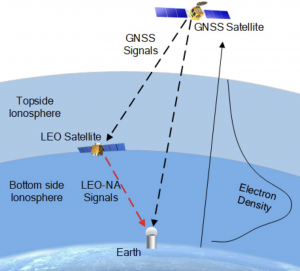Tao Li1, Lei Wang1,2, Wenju Fu1, Yi Han1, Haitao Zhou1, Ruizhi Chen1,2
1 State Key Laboratory of Information Engineering in Surveying, Mapping and Remote Sensing, Wuhan University, Wuhan, China
2 Collaborative Innovation Center for Geospatial Technology, Wuhan, China
Published in GPS Solutions (2022) 26:6, https://doi.org/10.1007/s10291-021-01189-w

Abstract
The ionospheric delay is still a major challenge for achieving precise global positioning since current global ionospheric modeling techniques still cannot meet precise data processing requirements. The low earth orbiters (LEO) navigation augmentation (LEO-NA) signals can be considered a new tool for the bottom ionospheric sensing, which has higher temporal–spatial resolution than the existing GNSS signals. A fully deployed LEO constellation hopefully enables continuous monitoring of the global ionosphere. The LEO-based ionospheric modeling involves two parts: the topside and the bottomside ionospheric modeling. The bottomside ionospheric sensing still confronts a few challenges. This study first attempts to build a regional bottomside ionospheric map (RBIM) using the LEO-NA signals from the Luojia-1A satellite. The proposed RBIM model is particularly suitable for the regional ionospheric model with limited LEO-NA observations. The area analyzed covered the southeast of China when the solar activity was low (13–14 January 2019). Two RBIM with 2.5° × 5° and 1° × 1° spatial resolution were established. Initial experiment results indicate the RMS of the RBIM model residuals for 2.5° × 5° and 1° × 1° achieve 0.90 and 0.33 TECU, respectively. Comparing the vertical bottomside electron content (VBEC) derived from RBIM with the global ionospheric map (GIM) and the regional ionospheric map (RIM), the overall RMS of the differences are 1.70 and 1.40 TECU, respectively, during the experiment period. The comparison between the differenced slant bottomside electron content (dSBEC) derived from observations and ionospheric models indicates that the RBIM significantly outperforms the GIM and RIM models.